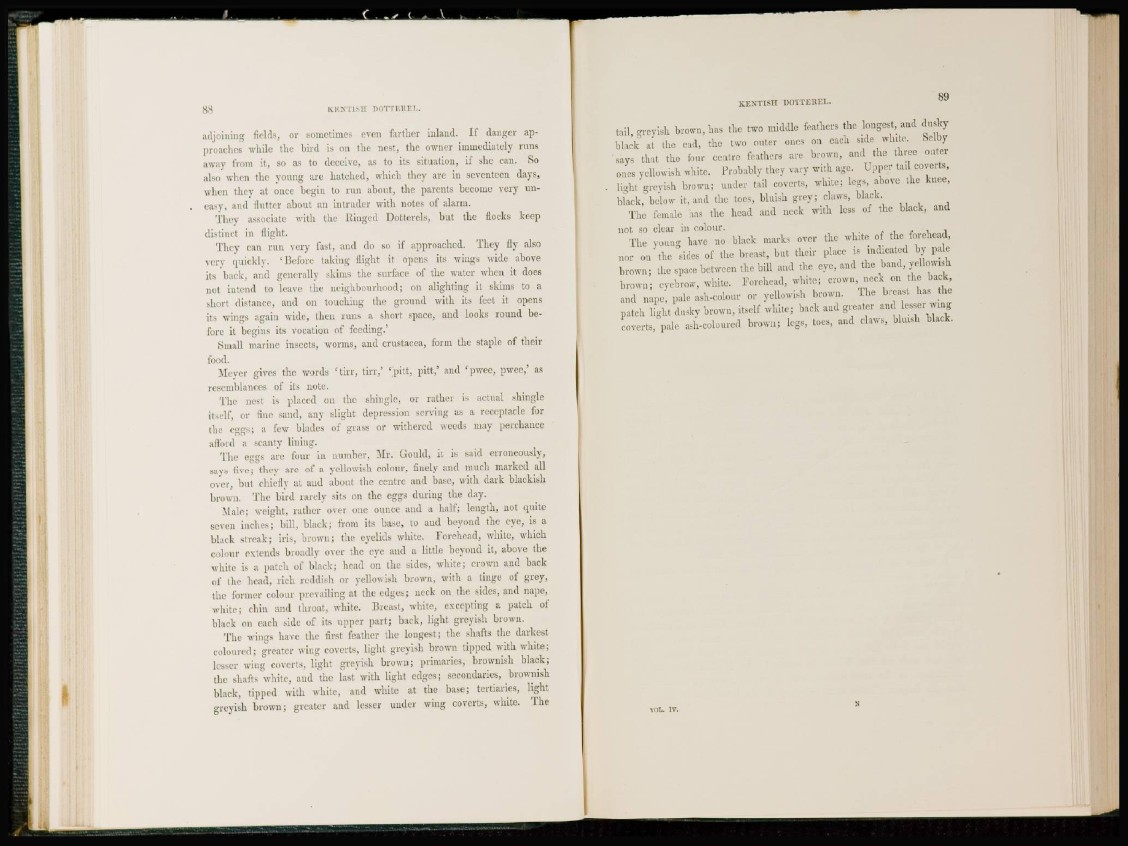
88 KENTISH DOTTERE!,.
adjoining fields, or sometimes even farther inland. If danger approaches
while the bird is on the nest, the owner immediately runs
away from it, so as to deceive, as to its situation, if she can. So
also when the young arc hatched, which they arc in seventeen days,
when they at once begin to run about, the parents become very uneasy,
and flutter about an intruder with notes of alarm.
They associate with the Ringed Dotterels, but the flocks keep
distinct in flight.
They can run very fast, and do so if approached. They fly also
very quickly. c Before taking flight it opens its wings wide above
its back, and generally skims the surface of the water when it does
not intend to leave the neighbourhood; on alighting it skims to a
short distance, and on touching the ground with its feet it opens
its wings again wide, then runs a short space, and looks round before
it begins its vocation of feeding.'
Small marine insects, worms, and Crustacea, form the staple of their
food.
Meyer gives the words ' t i r r , tirr,' ' p i t t , pitt,' and 'pwee, pwee,' as
resemblances of its note.
The nest is placed on the shingle, or rather is actual shingle
itself, or fine sand, any slight depression serving as a receptacle for
t he eggs; a few blades of grass or withered weeds may perchance
afford a scanty lining.
The eggs are four in number, Mr. Gould, it is said erroneously,
says five; they arc of a yellowish colour, finely and much marked all
over, but chiefly at and about the centre and base, with dark blackish
brown. The bird rarely sits on the eggs during the day.
Male; weight, rather over one ounce and a half; length, not quite
seven inches; bill, black; from its base, to and beyond the eye, is a
black streak; iris, brown; the eyelids white. Forehead, white, which
colour extends broadly over the eye and a little beyond it, above the
white is a patch of black; head on the sides, white; crown and back
of the head, rich reddish or yellowish brown, with a tinge of grey,
the former colour prevailing at the edges; neck on the sides, and nape,
white; chin and throat, white. Breast, white, excepting a patch of
black en each side of its upper part; back, light greyish brown.
The wings have the first feather the longest; the shafts the darkest
coloured: greater wing coverts, light greyish brown tipped with white;
lesser wing coverts, light greyish brown; primaries, brownish black;
the shafts white, and the last with light edges; secondaries, brownish
black, tipped with white, and white at the base; tertiaries, light
greyish brown; greater and lesser under wing coverts, white. The
KENTISH DOTTEREL.
tail, greyish brown, has the two middle feathers the longest, and dusky
black at the end, the two outer ones on each side white. Selby
says that the four centre feathers arc brown, and the three outer
ones yellowish white. Probably they vary with age. Upper tail coverts,
light greyish brown; under tail coverts, white; legs, above the knee,
black, below it, and the toes, bluish grey; claws, black.
The female has the head and neck with less of the black, and
not so clear in colour.
The young have no black marks over the white of the forehead,
nor on the sides of the breast, but their place is indicated by pale
brown; the space between the bill and the eye, and the band, yellowish
brown; eyebrow, white. Forehead, white; crown, neck on the back,
and nape, pale ash-colour or yellowish brown. The breast has the
patch light dusky brown, itself white; back and greater and lesser wing
coverts, pale ash-coloured brown; legs, toes, and claws, bluish black.